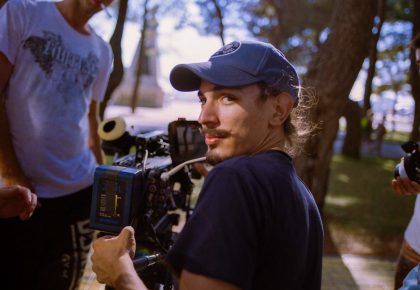
Cuadrilátero (Quadrilateral), Daniel Rodríguez Risco’s sixth feature film, is perhaps the most unique, sui generis, out there film of this year’s Festival. It’s darkly humorous, visually inventive, and even perturbing. It’s about power and control and survival of the fittest. It feels and looks like a perverse answer to Wes Anderson’s hyper-stylized films.
Adriana is the queen bee and general of a tightly run household of four that includes husband Alfredo, and their children, Lucia and Felipe. Everything must be perfectly structured: the family unit should consist of only four people; her furniture, decoration, even the way dinner is served on individual platters follow rigid geometrical patterns. Those strict parameters are jeopardized by the birth of her third child, Tomás. She solves it by locking him in a closet a la Harry Potter and forcing him to hide in the bushes outdoors. But Tomás turns the tables on the entire family when he discovers the books of one Ann Land in his sister’s bedroom, and the battle for control of this household and a new alpha begins.
A former Economics student turned entrepreneur and even University Dean, Daniel Rodríguez Risco started making short films in 1998 releasing one per year until 2005. His first short film, El colchón (1998), received the award for Best Short Film at Conacine (Peru). His next short, Triunfador (2019), was selected at the Festival du Court Métrages at Clermont-Ferrand and was distributed internationally by Canal-Plus. Thanks to these two shorts, he received a scholarship to study a Master of Fine Arts in Film at NYU’s Tisch School of the Arts.
Three of Daniel’s six features which were selected by the Chicago Latino Film Festival: El acuarelista (The Watercolorist, 2008, 25th edition of the Festival); El vientre (The Womb, 2014, 31st edition), and Siete Semillas (Seven Seeds, 2016, 35th edition), starring Javier Cámara and Federico Luppi in his last on-screen appearance.
We spoke to Daniel about the film’s visual design, Ayn Rand and who in their right mind would marry Adriana:
How was the idea for Cuadrilátero born and how does the film fit in your filmography in terms of styles, themes and even personal obsessions?
The trigger for the story was a commentary I overheard, by coincidence, from my wife who was talking on the phone to a friend who was about to give birth to her third child. When my wife hung up, she confirmed that they were talking about how this boy would change her friend’s family routine and dynamic. If it is true that the birth of a child can bring about a beautiful change, at the same time it provokes a series of complications—instability. This coincided with the release of my short Cuellos Almidonados [shown at the 39th CLFF] where I explored the dynamics of a family with three children where the mother is “the steward of order” and the younger son an “agent of disruption,” so the anecdote fit like a glove and allowed me to further explore this idea. When it comes to my filmography, Cuadrilátero follows the same line of my shorts which are these atemporal, non-geographical, slightly autobiographical short fables.

You present a very precise, geometrically perfect household and world where everything, from the furniture to the hill that leads the family to the car garage follow a specific rigid stricture. It’s also rather monochromatic and austere. Can you talk a bit about the film’s production design?
I had a lot of fun creating this quadrilateral, monochromatic world with my production designer Edi Mérida and my director of photography Miguel Valencia. We all collaborated on Cuellos Almidonados. To visually show the lack of communication [in this family], we decided to place each character at the border of the frame and add weight over them (beams, rafters) so that they would feel as if they were being crushed. Once you define how your film is going to look, which is like the rules of a game, it is key that you do not steer away from it to maintain the film’s unity and cohesion. One of our rules was: less is more.
We see Lucía read a book written by one Ann Land, and in fact, nothing but books by this author on her shelves. This author, in fact, inspires Tomás to take matters into his own hand. Is Ann Land a wink to Ayn Rand? And why?
Funny that you noticed that. My dad was a huge fan of Ayn Rand so I grew up reading her books: The Fountainhead, Atlas Shrugged, Night of October 16th, The Virtue of Selfishness (Gordon Gekko’s speech in Wall Street is taken from that book). I must have read everything she wrote. I believe something as radical, or even more so, than Rand’s “Objectivism” —[in defense] of an exacerbated individualism— most have stuck in Adriana’s, the mother’s, mind for her to behave the way she does. And I imagine she must have passed Land’s almost Darwinian ideology to her husband and children, except for Tomás who injects himself with it, encouraging him to rebel.
One of the most troubling aspects of your film is that we never know what social, political or even family-driven factors drove Adriana to be so severe, so authoritarian. What was her environment growing up like? And who in their right mind would marry her?
The answer to these two questions are tied to your previous one. Adriana must have grown up in an environment where that culture of egoism, in contrast to an altruistic one that defends the common good, was the norm. We never know the reasons why Alfredo, her husband, submits to Adriana the way he does. I didn’t find it pertinent to go into his backstory but in my mind, he must have some sort of moral debt with her: he must have been unfaithful to her at some point and in order not to lose his family, he took on a passive role.
In the end, this is a movie about the use and abuse of power and the cruelty it inspires. And we live in a world where cruelty for the mere sake of being cruel seems to be the norm for many governments. In what ways does this family represent a microcosm of the world we currently live in?
Your question reminds me of that memorable verse from John Donne’s poem: “No man is an island”. To tell you the truth, some of my movies, the most personal ones, are an artistic recreation of past events that could have become either painful or traumatic. Treating them artistically, so to say, allows me to distance myself from them, to look at them from the other side and even laugh at them. Cuadrilátero is one of those cases of artistic expression as therapy. Which is why it’s been a pleasant surprise to discover how the public goes beyond this family microcosm to themes like the ones you mention. I didn’t think I was making a political movie but I know I did thanks to the audience.
Cuadrilátero will screen on Saturday, April 12th at 4 p.m. and Sunday, April 13, 8 p.m. at the Landmark Century Center Theatres.

